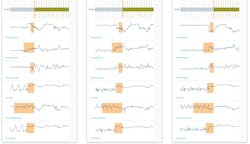Apply “Ready-to-Use” Machine Learning to Improve Industrial Operations
While the term “machine learning” generally relates to understanding structures or patterns in data, it can also refer to a very diverse set of activities and techniques. Most of us have experienced machine learning in our everyday lives with natural language processing (Alexa, Siri), image recognition (Facebook, Pinterest), purchase recommendations (Amazon) and search optimization (Google). These approaches generally use many different types of algorithms (e.g., neural networks, decision trees, clustering, support vector machines, etc.)
Industrial operations, on the other hand, need more specialized approaches that can provide actionable insights to reduce downtime as well as improve throughput, operator safety, and product quality. Whether you call it Industry 4.0 or Industrial IoT or Digital Operations, the increased access to operational data, combined with the spread of computing, connectivity, and storage, has created the perfect environment for transforming industrial operations.
The real opportunity is in unlocking the value of this data. However, due to the complexity of the systems and volume of data, traditional operational analytics haven’t been adequate.
The time-series data generated in discrete manufacturing or industrial process operations is very rich in information. It can provide insights on the current and future health of production equipment and lines.
Nearly all operational systems (e.g., manufacturing lines, industrial equipment, data centers, handheld devices) produce streams or bursts of time-series data in the form of sensor readings, log entries, or activity traces. The ability to better understand the behavior of these systems using this type of data is of extremely high value, but requires expertise in machine learning that’s focused on multivariate time-series data.
Pattern Learning: The Cornerstone of Predictive Analytics
Unfortunately, much of this time-series data goes underutilized because traditional tools and technologies have been unable extract actionable insights from this data for improving operations. A key source of insights in time-series data comes from multivariate trends, also called patterns, which are often reviewed forensically to understand past system behavior.
Patterns are often hard to describe and need to be learned from many signals across data sources. As a result, traditional analytics approaches are unable to effectively learn or recognize time-series patterns.
Time-series machine learning addresses this by identifying patterns hidden in time-series data, including those that would go undetected by the human eye. Machine learning has emerged as the leading approach to maximize the value of operational data through pattern recognition. Machine learning enhances this by not just recognizing defined patterns, but by its ability to learn and identify new ones and correlate them to operational events. With this is in place, the system can then perform pattern recognition, condition monitoring, and predictive analytics in real time on your existing operational data.
Understanding Patterns in Operational Data
1. Pattern recognition can be used on multivariate time-series data sets.
Now that you have seen how machine learning can be applied to pattern recognition, lets understand more about the patterns themselves by observing Figure 1. Three elements of pattern recognition are important to note:
- Patterns are temporal. This means patterns have both elements of shape and time. As seen in Fig. 1, each measured signal has large variations over the same period of time. One example would be monitoring temperature, force, and motor current ranges over time during a manufacturing process, where variations can impact yield or quality. A purely visual representation, as shown, is insufficient to spot operational pattern irregularities and predict undesirable conditions before they occur. However, each vertical orange hash indicates the point in time when conditions transition from one state to another, e.g. from normal to a precursor of an event.
- Patterns are multivariate. Seldom does the behavior of any one signal over time “tell the whole story” of what’s going on in a complex system. Only by examining the behavior of multiple signals over the same time period can we deduce a clear understanding of the state of a system. A large number of signals may be required to characterize the system behavior, and in many cases, it’s difficult to know ahead of time which signals or waveforms are significant. The combination of multiple signals, each with many distinct trends, makes any signal-by-signal, bottoms-up approach impractical.
- Patterns are complex and need to be discovered. Real systems create so much variation that time-series patterns can’t be discovered manually. In many cases, the patterns that represent precursors to future problems aren’t known prior to analysis. They need to be discovered. Pattern discovery is a major benefit of machine-learning algorithms and starts with prioritizing the problem to be solved.
Addressing Challenges with Time-Series Data
Machine learning that’s focused on multivariate time-series data and temporal patterns requires special consideration. Adding a time dimension to data significantly increases the challenges associated with machine learning, and success requires specific approaches and focus.
Specific challenges that need to be addressed with time-series data and temporal pattern recognition include:
- Interpret complex multivariate signals and extract features: While feature extraction approaches from time-series data exist (e.g., ARIMA, RNNs, SAX), they often can’t be directly applied to the raw signal data present in many scenarios. It’s important to make use of available signal analysis and information theory tools such as spectral analysis, compression, resampling, and window optimization to pragmatically address complexity and scale issues in the data.
- Limitations to labeling known behaviors: A key objective of machine learning with time-series data is to classify behaviors captured in that data into states or “conditions” of the associated system. These conditions are episodic—they start at some time and end at some later time. In many cases, conditions aren’t known in advance and need to be discovered. Time-series machine learning, therefore, needs to support unsupervised and semi-supervised models, and it needs to be able to build recognition from small numbers of example conditions.
- Ease of use for operations teams: The traditional machine-learning project approach—data scientists construct a custom model over a period of months and then hand it over to the industrial subject-matter experts (SMEs)—isn’t practical and scalable for most operational problems. The optimal solution is when the machine-learning system can be used by industrial SMEs themselves without much effort. The SMEs can select, structure, and feed existing multivariate time-series data generated by their operations into the machine-learning system and, based on the predictive insights and alerts provided by the system, determine the corrective action to be taken.
- Support real-time streaming analysis: Standard analytics middleware doesn’t provide feature extraction capabilities from time-series data. The signal data may need to be buffered so that a window of prior history can be fed into the model. Synchronization needs to be achieved in processing of multiple signals, each of which may have different sampling rates. Gaps in signal data need to be managed.
Implementing Machine Learning and Pattern Recognition
The core requirement of any machine-learning system is its ability to discover multivariate patterns in real time, and correlate them with events to deliver actionable insight. Figure 2 shows an example of predictive analytics by applying machine learning to time-series data.
2. Predictive analytics enabled by machine learning can anticipate problems before they occur.
With “ready-to-use” machine learning, historical data can be selected, patterns discovered, and models built and verified—all without the need for a data scientist or third-party consultants, significantly reducing the cost and time to value. Furthermore, this approach is highly versatile and can be applied across a vast range of industries and applications.
Case Study: Ciner Resources Digital Transformation
Ciner Resources operates a mining and processing facility (Fig. 3) in Wyoming that makes soda ash, a substance used in the production of glass and chemicals. It mines a natural substance called Trona, which is then dissolved to separate the desired soda ash from insoluble impurities. Insoluble impurities go into a machine called the Vertimill, which grinds them further to extract any trapped soda ash.
The challenge Ciner faced was that the grade of the ore it mined varied. Low-grade ore often resulted in unexpected downtimes due to the Vertimill clogging from too much insoluble impurities. When the Vertimill went down, 60% of the plant’s production rate was lost, which was costing up to $720,000 per day in lost production.
3. Ciner Resources operates a mining and processing facility in Wyoming. By applying “ready-to-use” machine learning to multivariate time-series data, developers were able to identify time periods of “low-quality ore” events, as well as times when there was an inadequate grinding media charge. (Courtesy of Ciner Resources)
Traditional lab analysis of the ore to determine whether it is “quality” can only be performed after it’s processed. They had no real-time way to assess the ore earlier in the process to estimate the volume of impurities that would enter the Vertimill.
Ciner’s plant operations team identified 10 streams of process data that were generating as ore made its way from the ore bin through a calciner, conveyors, and agitators. By applying “ready-to-use” machine learning to this multivariate time-series data, they were able to identify time periods of “low-quality ore” events, as well as times when there was an inadequate grinding media charge.
Subsequently, the machine-learning application was able to develop prediction models for these undesired events. This enabled the operations team to intervene whenever these patterns were detected in order to adjust the flow of material into the Vertimill. This helped ensure not only that the Vertimill didn’t get overloaded and go offline, but also that operators didn’t act overly cautious and reduce flow into the Vertimill when it wasn’t necessary, since this action would slow production.
Thanks to machine learning and pattern recognition, the operators now have better real-time visibility into the ore-refining process and can set alarms based on issues that show up earlier in the process. Insolubles from low-quality ore build up hours before the Vertimill is affected. And now, because such buildups are identified earlier, there’s time to take corrective rather than reactive action. The business benefit is reduced production losses and cost savings from avoiding unplanned maintenance.
Actionable Intelligence for Optimizing Operations
Industrial organizations are moving quickly to implement “ready-to-use” machine learning systems to gain competitive advantages and optimize their operations. The core requirement of any machine-learning system in this context is that it’s designed to solve the complex problems facing industrial organizations today.
This approach will maximize the value derived from the operations data and the effectiveness of the machine learning investment. The end result is substantial improvements in asset performance, practitioner safety, manufacturing yield, and product quality.
Sanket Amberkar is Senior Vice President, Marketing, at Falkonry.
Reference:
About the Author
Sanket Amberkar
Senior Vice President, Marketing
Sanket leads marketing at Falkonry and is responsible for the company’s positioning, thought leadership, and go-to market strategy. Sanket has over 20 years of experience in the high tech, energy, industrial, and automotive markets in areas ranging from of product development to market strategy. Prior to Falkonry, he was VP of Product Marketing for Innovation & New Ventures at Flex, where he brought to market its Innovation services and launched the LabIX startup initiative. Earlier, he led marketing and product development teams at Cisco and Delphi.
Sanket holds Master’s degrees in Electrical Engineering and Business Administration, both from the University of Michigan. He is a frequent industry speaker and holds 13 U.S. patents.




